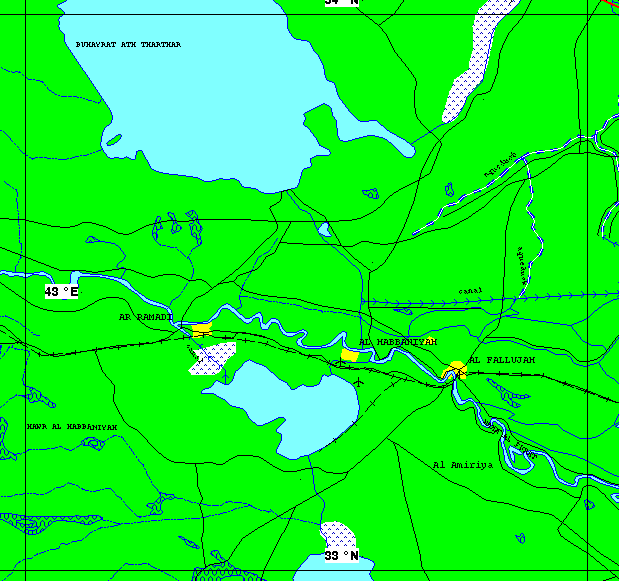





The palace of Maqar-el-Tharthar [the so-called "Green Palace"] at Lake Tharthar is the biggest and most elaborate of President Saddam's palaces, built on the shore of an artificial lake. Located 150 miles north of Baghdad in Saddam's home region, this site was completed in November 1993. It covers two and a half square miles and consists of a Presidential and VIP residential compounds. It is second only to the President's Tikrit residence in overall size.
Tharthar in central Iraq is known to be Hussein's favorite place for fishing. Built on Tharthar Lake, the 1-square-mile compound has 45 structures, including guest houses for VIPs. The nearby Saddamiat al Tharthar is a resort city built for regime VIP's. Saddam celebrated his birthday in 1999 by building this resort complex for regime loyalists. This lakeside resort with stadiums, an amusement park, hospitals and new homes, was built at a cost of hundreds of millions of dollars. Apparently at least one journalist [Joel Soler] willing to write about the sanctions was also able to visit the Tharthar resort. In 1997 the International Atomic Energy Agency (IAEA) Nuclear Monitoring Group (NMG) completed the second of its two-phased verification of activities in connection with Iraq's declared destruction and concealment of material and equipment related to its clandestine nuclear programme. The first phase of these verification activities involved searches at three sites to the south of Lake Tharthar, using sub-surface sensing technologies provided and implemented by a supporting member State, which facilitated the location, excavation and identification of buried items (particularly metallic items). The material and equipment recovered at the Tharthar sites originated from Iraq's past gaseous diffusion and gas centrifuge uranium enrichment programmes. The number and nature of items found appear to be consistent with the statements made by Iraq in its '"Full, Final and Complete Declaration" of its nuclear programme (FFCD). As previously declared by Iraq, the bulk of the recovered equipment had been destroyed. However, there was also a large number of specialised, high- value, corrosion resistant valves which wore in "as new" condition. According to the Iraqi counterpart, these valves had been purchased for potential use in centrifuge cascade circuits. The second phase of the search and excavation activity was completed in May 1997 with the survey of nine other sites. [IAEA]The special group of UN Special Commission for Iraq (UNSOM) weapons inspectors, diplomats and representatives of the International Atomic Energy Agency (IAEA) completed its initial inspections of Iraqi presidential sites on 02 April 1998. It took eight days to complete the so-called baseline inspections of the presidential sites. Access to these sites, which Iraq had declared off limits to the United Nations, was granted only after Secretary General Kofi Annan signed an agreement with Iraqi President Saddam Hussein during his visit to Baghdad last month which allows UN weapons experts, accompanied by a special group of "diplomatic observers," to inspect the compounds. Unfettered access to these and other sites is one of the conditions that must be met to complete the weapons inspections and ultimately lift UN sanctions.
All eight "presidential sites" visited appeared to be well defined by high walls or fences. They all had a rather similar landscape pattern: main guesthouses, with an integrated system of ancillary buildings and villas for accompanying dignitaries. Often an artificial lake with small artificial decorative islands located in a way to give access to the lake from each guesthouse. The mission was not intended to be a search for prohibited material and none was found. In fact, there was very little equipment, documentation or other material in the sites at all. It was clearly apparent that all sites had undergone extensive evacuation. In all the sites outside of Baghdad, for example, there were no documents and no computers. The buildings were largely empty. A key accomplishment of the mission was to plot more precisely the boundaries of the presidential sites.This site was visited on 30 March 1998 by a major part of the Special Group. Aerial photography was undertaken. An issue regarding the boundary survey was resolved satisfactorily by the Iraqi authorities volunteering to move air defence batteries further away to prevent any confusion in the future. Those responsible for the technical management of the site were on hand to provide information.
In the 1950s a barrage was constructed on the Tigris in order to divert the spring flood waters down Wadi Tharthar, and end the disastrous flooding of Baghdad by storing extra water discharge upstream of the Samarra barrage. The scheme was one of the largest undertaken in Iraq. Some hydro power is also produced. Planning of the New Town of Tharthar in Iraq began in 1985. A derivation canal that links the Tigris to the Euphrates through the Tharthar Valley has already been realized and operative since 1988. Iraq can tap the waters of the Tigris by using canals and so employing water which would otherwise go unused. The Tharthar canal links the Euphrates and the Tigris. The lake formed behind the Tharthar barrage drove the farming communities of the flood plain onto the steppe-land among the Abbasid ruins of Samarra' and enlarged the town, which remains the market center of its district. Samarra' is a town on the east bank of the middle Tigris in Iraq, 125 km north of Baghdad, Between the years 836-892 AD it was the capital of the Abbasid Caliphs. Samarra' expanded to an occupied area of 57 km▓, one of the largest cities of ancient times, whose remains of collapsed pisÚ and brick walls are still largely visible. Samarra' is now one of the largest archaeological sites in the world.

